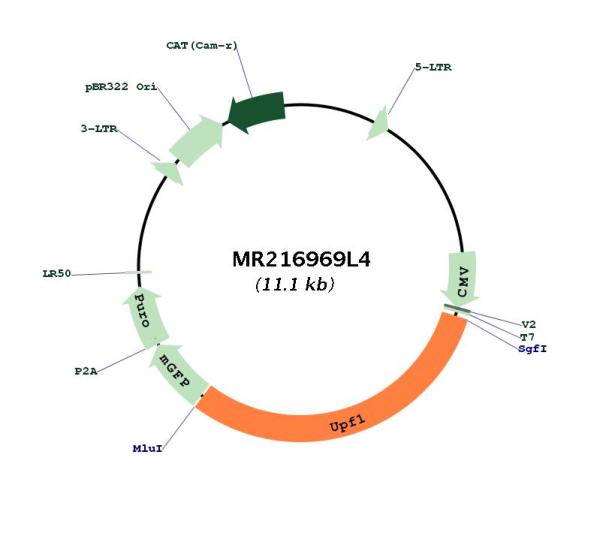Upf1 (NM_001122829) Mouse Tagged Lenti ORF Clone
CAT#: MR216969L4
- LentiORF®
Lenti ORF clone of Upf1 (mGFP-tagged) - Mouse UPF1 regulator of nonsense transcripts homolog (yeast) (Upf1), transcript variant 1
"NM_001122829" in other vectors (4)
Interest in protein/lysate? Submit request here!
USD 365.00
Specifications
| Product Data | |
| Type | Mouse Tagged ORF Clone |
| Tag | mGFP |
| Symbol | Upf1 |
| Synonyms | B430202H16Rik; NORF1; PNORF-1; Rent1; Upflp |
| Vector | pLenti-C-mGFP-P2A-Puro |
| E. coli Selection | Chloramphenicol (34 ug/mL) |
| Mammalian Cell Selection | Puromycin |
| Sequence Data |
The ORF insert of this clone is exactly the same as(MR216969).
|
| Restriction Sites |
SgfI-MluI
Cloning Scheme for this gene
Plasmid Map

|
| ACCN | NM_001122829 |
| ORF Size | 3372 bp |
| OTI Disclaimer | The molecular sequence of this clone aligns with the gene accession number as a point of reference only. However, individual transcript sequences of the same gene can differ through naturally occurring variations (e.g. polymorphisms), each with its own valid existence. This clone is substantially in agreement with the reference, but a complete review of all prevailing variants is recommended prior to use. More info |
| OTI Annotation | This clone was engineered to express the complete ORF with an expression tag. Expression varies depending on the nature of the gene. |
| Product Components | The ORF clone is ion-exchange column purified and shipped in a 2D barcoded Matrix tube containing 10ug of transfection-ready, dried plasmid DNA (reconstitute with 100 ul of water). |
| Reconstitution | 1. Centrifuge at 5,000xg for 5min. 2. Carefully open the tube and add 100ul of sterile water to dissolve the DNA. 3. Close the tube and incubate for 10 minutes at room temperature. 4. Briefly vortex the tube and then do a quick spin (less than 5000xg) to concentrate the liquid at the bottom. 5. Store the suspended plasmid at -20°C. The DNA is stable for at least one year from date of shipping when stored at -20°C. |
| Reference Data | |
| RefSeq | NM_001122829.2, NP_001116301.1 |
| RefSeq Size | 4657 bp |
| RefSeq ORF | 3375 bp |
| Locus ID | 19704 |
| UniProt ID | Q9EPU0 |
| Cytogenetics | 8 34.15 cM |
| Gene Summary | RNA-dependent helicase and ATPase required for nonsense-mediated decay (NMD) of mRNAs containing premature stop codons. Is recruited to mRNAs upon translation termination and undergoes a cycle of phosphorylation and dephosphorylation; its phosphorylation appears to be a key step in NMD. Recruited by release factors to stalled ribosomes together with the SMG1C protein kinase complex to form the transient SURF (SMG1-UPF1-eRF1-eRF3) complex. In EJC-dependent NMD, the SURF complex associates with the exon junction complex (EJC) (located 50-55 or more nucleotides downstream from the termination codon) through UPF2 and allows the formation of an UPF1-UPF2-UPF3 surveillance complex which is believed to activate NMD. Phosphorylated UPF1 is recognized by EST1B/SMG5, SMG6 and SMG7 which are thought to provide a link to the mRNA degradation machinery involving exonucleolytic and endonucleolytic pathways, and to serve as adapters to protein phosphatase 2A (PP2A), thereby triggering UPF1 dephosphorylation. UPF1 can also activate NMD without UPF2 or UPF3, and in the absence of the NMD-enhancing downstream EJC indicative for alternative NMD pathways. Plays a role in replication-dependent histone mRNA degradation at the end of phase S; the function is independent of UPF2. For the recognition of premature termination codons (PTC) and initiation of NMD a competitive interaction between UPF1 and PABPC1 with the ribosome-bound release factors is proposed. The ATPase activity of UPF1 is required for disassembly of mRNPs undergoing NMD (By similarity). Essential for embryonic viability.[UniProtKB/Swiss-Prot Function] |
Documents
| Product Manuals |
| FAQs |
| SDS |
Resources
Other Versions
| SKU | Description | Size | Price |
|---|---|---|---|
| MC223643 | Upf1 (untagged) - Mouse UPF1 regulator of nonsense transcripts homolog (yeast) (Upf1), transcript variant 1, (10ug) |
USD 1,077.00 |
|
| MG216969 | Upf1 (tGFP-tagged) - Mouse UPF1 regulator of nonsense transcripts homolog (yeast) (Upf1) transcript variant 1, (10ug) |
USD 1,178.00 |
|
| MR216969 | Upf1 (Myc-DDK-tagged) - Mouse UPF1 regulator of nonsense transcripts homolog (yeast) (Upf1), transcript variant 1 |
USD 978.00 |
|
| MR216969L3 | Lenti ORF clone of Upf1 (Myc-DDK-tagged) - Mouse UPF1 regulator of nonsense transcripts homolog (yeast) (Upf1), transcript variant 1 |
USD 1,278.00 |
{0} Product Review(s)
Be the first one to submit a review






























































































































































































































































 Germany
Germany
 Japan
Japan
 United Kingdom
United Kingdom
 China
China

